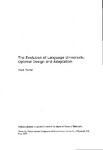The Evolution of Language Universals: Optimal Design and Adaptation
| dc.contributor.author | Turner, Huck | |
| dc.contributor.other | Faculty of Science and Engineering | en_US |
| dc.date.accessioned | 2013-09-19T10:37:39Z | |
| dc.date.available | 2013-09-19T10:37:39Z | |
| dc.date.issued | 2007 | |
| dc.identifier | NOT AVAILABLE | en_US |
| dc.identifier.uri | http://hdl.handle.net/10026.1/1873 | |
| dc.description.abstract |
Inquiry into the evolution of syntactic universals is hampered by severe limitations on the available evidence. Theories of selective function nevertheless lead to predictions of local optimaliiy that can be tested scientifically. This thesis refines a diagnostic, originally proposed by Parker and Maynard Smith (1990), for identifying selective functions on this basis and applies it to the evolution of two syntactic universals: (I) the distinction between open and closed lexical classes, and (2) nested constituent structure. In the case of the former, it is argued that the selective role of the closed class items is primarily to minimise the amount of redundancy in the lexicon. In the case of the latter, the emergence of nested phrase structure is argued to have been a by-product of selection for the ability to perform insertion operations on sequences - a function that plausibly pre-dated the emergence of modem language competence. The evidence for these claims is not just that these properties perform plausibly fitness-related functions, but that they appear to perform them in a way that is improbably optimal. A number of interesting findings follow when examining the selective role of the closed classes. In particular, case, agreement and the requirement that sentences have subjects are expected consequences of an optimised lexicon, the theory thereby relating these properties to natural selection for the first time. It also motivates the view that language variation is confined to parameters associated with closed class items, in turn explaining why parameter confiicts fail to arise in bilingualism. The simplest representation of sequences that is optimised for efficient insertions can represent both nested constituent structure and long-distance dependencies in a unified way, thus suggesting that movement is intrinsic to the representation of constituency rather than an 'imperfection'. The basic structure of phrases also follows from this representation and helps to explain the interaction between case and theta assignment. These findings bring together a surprising array of phenomena, reinforcing its correctness as the representational basis of syntactic structures. The diagnostic overcomes shortcomings in the approach of Pinker and Bloom (1990), who argued that the appearance of 'adaptive complexity' in the design of a trait could be used as evidence of its selective function, but there is no reason to expect the refinements of natural selection to increase complexity in any given case. Optimality considerations are also applied in this thesis to filter theories of the nature of unobserved linguistic representations as well as theories of their functions. In this context, it is argued that, despite Chomsky's (1995) resistance to the idea, it is possible to motivate the guiding principles of the Minimalist Program in terms of evolutionary optimisation, especially if we allow the possibility that properties of language were selected for non-communicative functions and that redundancy is sometimes costly rather than beneficial. | en_US |
| dc.language.iso | en | en_US |
| dc.publisher | University of Plymouth | en_US |
| dc.title | The Evolution of Language Universals: Optimal Design and Adaptation | en_US |
| dc.type | Thesis | en_US |
| plymouth.version | Full version | en_US |
| dc.identifier.doi | http://dx.doi.org/10.24382/1286 |
Files in this item
This item appears in the following Collection(s)
-
01 Research Theses Main Collection
Research Theses Main


